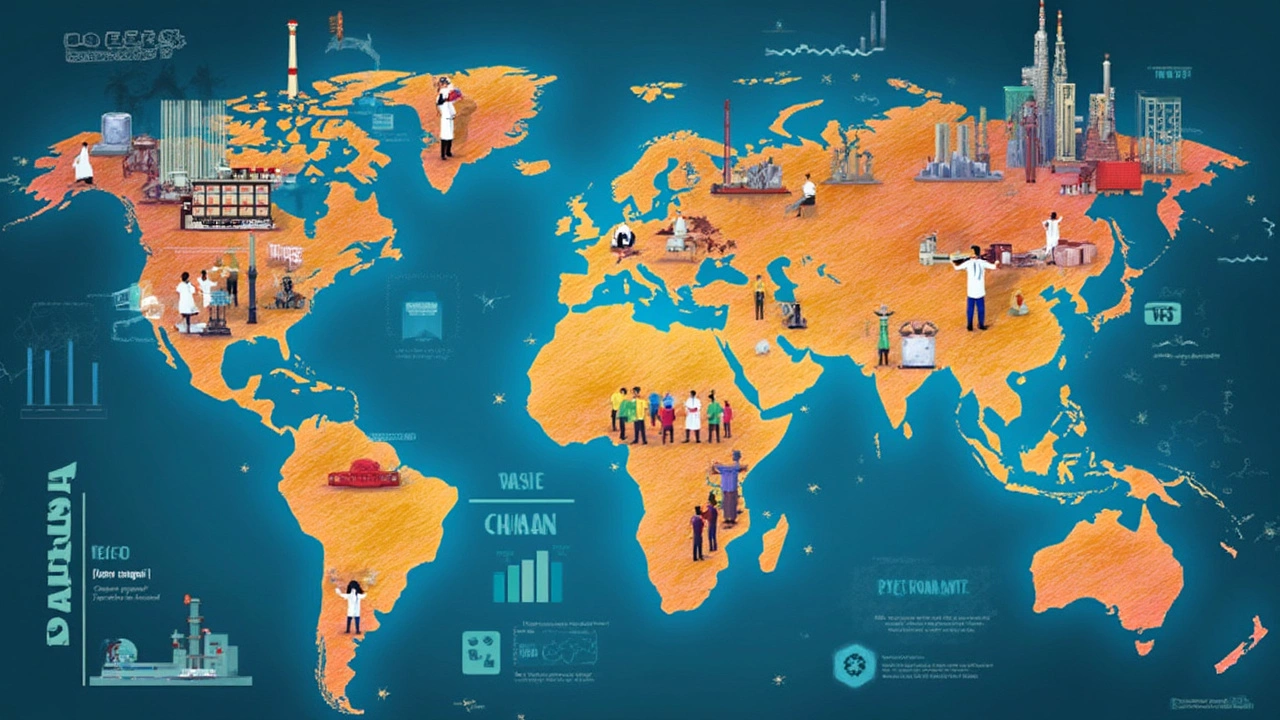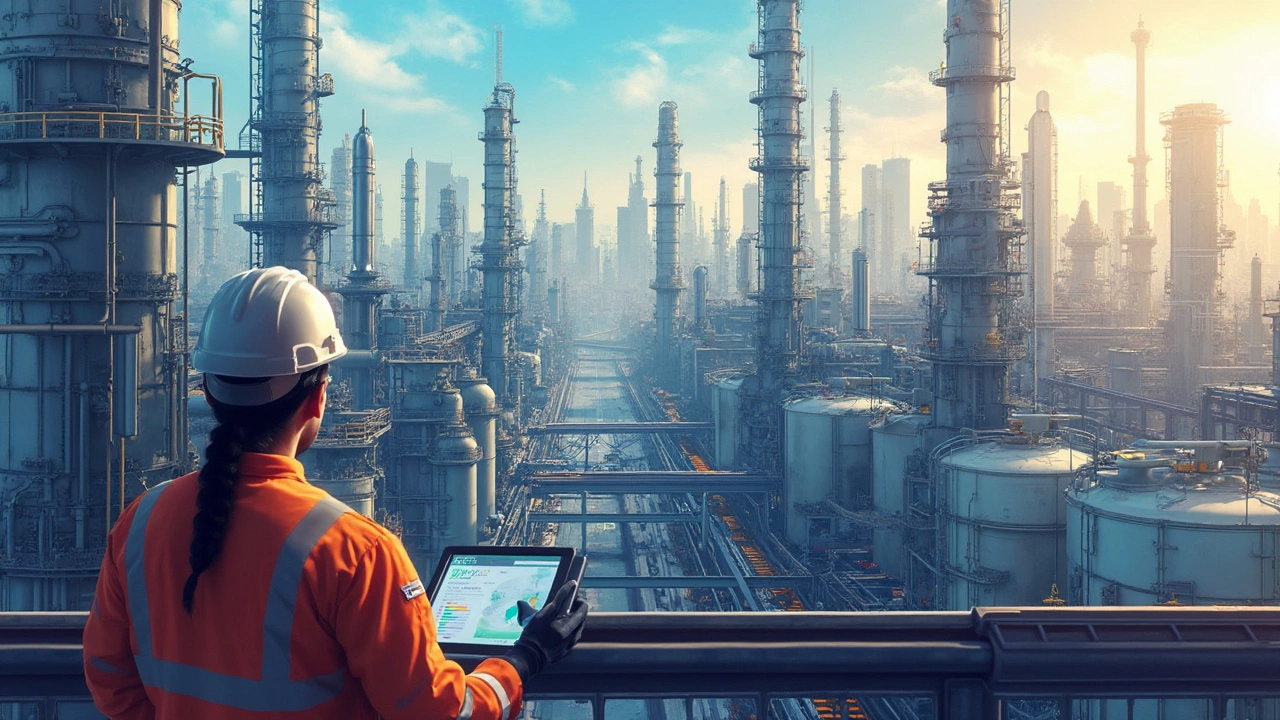Walk through any supermarket or hardware store, and you’ll be hit with row upon row of products that owe their existence to the chemical industry. There’s hardly an area of everyday life that doesn’t touch chemicals: from the paint on your walls to the fertilizer for your plants, to the plastic packaging for your takeaway noodles, even the batteries powering your gadgets. But have you ever thought about where all these chemicals are coming from? The truth is, not every country manufactures them equally—and the leader might surprise you. The chemical industry is a colossal machine, churning out vital ingredients for pretty much every sector you can imagine, so which country stands at the top in producing them and running the largest number of chemical companies? Let’s break it all down and look into why the rankings are not as obvious as you might think.
The Chemical Industry: What It Is and Why It Matters
The global chemical industry is a beast. In 2023, it generated more than 5 trillion US dollars, making it one of the world’s biggest markets, only lagging behind energy and food. For clarity, a chemical company isn’t just a lab mixing up some bubbling potions; these are corporations designing huge quantities of substances for everything from pharmaceuticals to paints, adhesives to fertilizers, plastics to cleaning agents. They feed raw materials to tens of thousands of other industries.
What’s mind-blowing is how the industry serves as the backbone for almost every consumer product you touch each day. If you look at a country’s chemical sector, you’re pretty much peeking at the core of its economy. In most places, the chemical sector makes up between 5-10% of all manufacturing output—and sometimes even more.
Asia dominates the market today, with more than half of global chemical sales coming from countries like China, India, Japan, and South Korea. But the true measure of dominance isn’t only the value of sales—sometimes it’s the number of active companies weaving innovation and employment into the fabric of a nation’s economy. Some countries might have a few massive players, while others are packed with thousands of smaller manufacturers.
One more fascinating twist: the definition of a “chemical company” shifts a bit depending on where you are. In the US, a chemical firm might specialize in refining petroleum products, while in Germany, you’ll get companies focusing on advanced polymers or specialty chemicals. This subtle difference shapes the count and classification of companies. Curious which country leads in raw numbers? Time to dig deeper.
A Look at the Numbers: Which Country Has the Most Chemical Companies?
Alright, numbers time. You might think it’s the US or Germany topping the charts for most chemical companies, given their history of giants like BASF, Dow, and DuPont. But no, the answer is clear: China is the undisputed king in both number and growth of chemical companies. According to statistics from China’s Ministry of Industry and Information Technology, as of 2023, there are tens of thousands (estimates put it at over 25,000) officially registered chemical manufacturers in China—and that’s not even counting informal, smaller operations under the radar.
A few reasons explain this dominance. First, China’s population is huge, so demand for industrial chemicals, plastics, and fertilizers is sky-high. Second, China invested heavily in building massive chemical industrial parks, with entire regions specializing in petrochemicals or fine chemicals, attracting endless entrepreneurs and foreign investment.
It’s worth pointing out Germany, legendary for its precision and quality in chemicals, is nowhere near China’s company count. Germany has around 2,000 chemical companies registered, according to the German Chemical Industry Association (VCI), but many are small-to-mid-sized, heavily specialized, and often family-owned operations. For scale, the whole of Europe has around 30,000 companies, though most are niche, producing high-value or specialty chemicals. The US follows with about 13,000 chemical manufacturing establishments, as per US Census Bureau data.
India is climbing fast, with over 10,000 chemical manufacturing firms, many clustered in regions like Gujarat and Maharashtra. A lot of growth in the Indian sector comes from pharmaceuticals and crop protection chemicals. Japan and South Korea also make the leaderboard, but with fewer, highly efficient firms.
Why does China have so many compared to giants like the US and Germany? One obvious reason: low entry barriers and government incentives. Many Chinese firms are privately owned or joint-ventures, and local authorities often encourage new start-ups to boost employment and tax revenue. This leads to a huge but fragmented landscape, where even small businesses make waves with innovations in plastics, pigments, or industrial solvents.
Don’t be fooled into thinking that more companies means better quality, though. The Chinese market is pretty competitive—some brands rise to international fame, while many others focus on local or niche trading.
The bottom line: chemical companies are thick on the ground in China, making it the world’s biggest hub by far in terms of sheer numbers.

Beyond the Numbers: Who Rules in Terms of Power and Innovation?
Let’s get real—size isn’t everything. The real muscle comes from companies with global influence: those that pioneer innovation, churn out billions in revenue, and set standards for the rest of the world. Think Dow, BASF, SABIC, Sinopec, and Mitsubishi Chemical. You’ll find household names in almost every major region, but their impact varies massively.
China’s top players—Sinopec, ChemChina, and Wanhua Chemical—are heavyweights by any global measure. Sinopec, for example, was the world’s largest chemical company by sales revenue in 2023, outpacing even the German giant BASF. Sinopec and ChemChina specialize in everything from petrochemicals to advanced polymers, serving markets from Asia to Africa.
But look at innovation, and Germany stands head and shoulders above most. BASF spends billions on research and development, inventing specialized plastics for autos, foods, and even battery science for electric vehicles. The US is no slouch either, packing its sector with “innovation clusters”: think Silicon Valley, but for chemicals, as seen along the Gulf Coast with companies like Dow, DuPont, Eastman, and Huntsman. The US leads in sectors like biotechnology chemicals, synthetic biology, and sustainable plastics.
Japan brings a twist—companies like Sumitomo Chemical and Mitsubishi Chemical aren’t just huge, they’re tech wizards, driving new materials for electronics, smartphones, and car batteries. South Korea’s LG Chem is making serious waves in the race to develop battery chemistry for electric cars. These innovative edges set these industry titans apart from the thousands of small, traditional manufacturers you might find in China or India.
So, while China leads in sheer number, the powerhouses of innovation are more scattered: Germany and the US for high-end research, Japan for electronic materials, and South Korea for next-gen batteries. If you’re looking to partner or invest in the cutting edge of the field, numbers alone aren’t the smartest guide—watch the heavy hitters punching above their weight.
Tangled Up: Environmental, Economic, and Social Impacts
All these chemical companies—big and small—produce more than just goods: they make a huge environmental footprint. China’s open policy toward new companies overwhelmed some local regulations, and several areas have suffered major pollution issues, from contaminated water tables to air pollution. In 2015, the Tianjin warehouse explosion was a scary wake-up call about safety standards and the risks that come with a vast, fast-growing sector. As a result, the Chinese government enforced stricter oversight, closing thousands of unsafe operations in recent years, but the challenge is far from over.
The US and Europe tend to regulate chemicals more tightly. The European Union has “REACH,” probably the strictest chemical regulation regime anywhere, requiring companies to prove product safety in excruciating detail before hitting the market. The US Environmental Protection Agency also keeps a close eye, although critics still argue about possible loopholes and lobbying. This regulatory pressure slows down new entrants but usually leads to safer outcomes for workers and the environment.
Innovation now isn’t just about who’s first; it’s about who’s cleaner and greener. New companies are racing to crack safer coatings for food, biodegradable plastics, plant-based dyes, and, especially in the wake of climate targets, chemicals derived from renewable resources. Germany’s BASF is betting big on bio-based solvents. US start-ups in the Bay Area are hacking the DNA of living microbes to make chemicals without oil at all.
The chemical industry remains one of the largest employers—China’s chemical sector alone supports millions, both directly and through spinoff activities like logistics and infrastructure. In Germany, the “Mittelstand” (mid-sized company sector) creates highly paid, secure jobs, often in small towns where the chemical firm is the heartbeat of the local economy. In the US, the Gulf Coast corridor isn’t just factories but an economic powerhouse with thriving communities built around chemical plants.
It’s a balancing act: pollution and accidents drive public backlash, but the sector is vital. Governments keep raising the bar, but the world’s thirst for plastics, cleaner fertilizers, advanced batteries, and ultra-light materials for cars and planes keeps the chemical industry humming. The future? More chemical companies are moving toward “circular economy” models: recycling absolutely everything, reducing waste, and getting closer to net-zero emissions.
The ultimate winner in the future might not be the one with the most companies, but the one that nails safety, innovation, and sustainability—and still manages to turn a solid profit.
